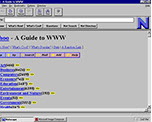POSTED 30.11.22 / BY C YATES
CUSTOMER AND DIGITAL EXPERIENCE
CATEGORIES
Design
Future
Connected
Methodology
Innovation
Technology
ABOUT ME
I am passionate about innovative design and creating user experiences at the intersection of art, science and technology.
RELATED POSTS
Design Methods
Cultivating Micro-Moments
More and more users when they visit a website are now expecting to see information that is relevant to them, when this works well it tends to increase user engagement and conversions. Research shows that organisations that personalise the customer experience achieve an average 19% conversion uplift. Businesses and organisations are becoming more aware of this and the potential that a truly connected customer experience across all channels can deliver. Companies are seeking to create teams to build their digital channels, spanning roles such as product designers, experience designers, digital strategists, developers, content authors, solution architects, and product owners.
A brief history of the Web
In the beginning there was Web 1.0! At this point, there were few content creators; most of those using the Internet were consumers or academics. Static pages were the most common way to consume content, which included interactive and animated websites with specific coding or language. Content in this stage came from a server’s filesystem rather than a database management system. Web browsers accessed hosting servers to get information, which was characterised as a “read-only” Internet. For the most part, web users simply surfed the web looking for information, and did not interact with the sites themselves in terms of returning user-generated data.
Then in 1999 Web 2.0 made its first appearance as the Internet pivoted toward a system that actively engaged the user. Users were encouraged to provide content, rather than just viewing it. People were now able to publish articles and comments, and it became possible to create user accounts on different sites, increasing participation. Web 2.0 also gave rise to web apps, self-publishing platforms like WordPress, as well as social media sites. Users could not only access information, but also send information back to the server to get more targeted information or other user generated results. This is where a variety of web services and content management systems took off as providers were able to use this interactivity to transform software services. Web 2.0 also got a major boost from cloud technology, where abstracting server hardware allowed companies to dream bigger when it came to offering web-delivered services.
We are now approaching Web 3.0 which has the potential to be disruptive and to usher in another paradigm shift. The fundamental idea of Web 3 is decentralisation, openness and increased consumer usefulness. Imagine a new kind of Internet that accurately translates what you type and understands what you say, whether through text, voice, or other media, and where all of the content you consume is more personalised than ever before.
As Web 1.0 and the Internet grew so the first content management systems (CMSs) appeared. These monolithic systems enabled brochure-like static content. By the late ‘90s, organisations were beginning to serve up the dynamic content that would give rise to Web 2.0. As the social web expanded with user-generated content and the rise of mobile, the need for more personalised engagement and deeper business integration led to web experience management (WEM) solutions. With WEM, organisations began gathering engagement data, building out personas, and using both to serve up more personalised experiences. WEM systems were mainly designed for marketing — and thus were hard to connect to the rest of the organisation’s technology stack, such as CRM or ERP systems. As digital experiences became more and more important to organisations and technology solutions proliferated, the need for deeper integrations grew, leading to the rise of headless, micro-services architecture. This offered two things; first it enabled integrations with other systems — such as CRMs, e-commerce systems etc., second it empowered developers to experiment with new touch-points. Together, these two capabilities paved the way for digital experience platforms (DXP) to provide a fully integrated customer experience flowing seamlessly across channels and devices, throughout the entire journey. Digital experience platform (DXP) can be defined as integrated technology solutions designed to enable the composition, management, delivery and optimisation of contextualised digital experiences across multi-platform customer journeys. DXP offer organisations a suite of tools to foster meaningful relationships by speaking and listening to customers, prospects, partners, employees, and other audiences.
With the introduction of Web 1.0 and the vast part of Web 2.0, design trends have focused on creating seamless or frictionless customer experiences (CX), where the outcome is geared towards usability, user journey, and actions. In the later-day Web 2.0 and approaching Web 3 this design approach may be less effective with the digital experience platforms that seek to optimise the customer experience. For a DXP to be effective, it requires a little friction. Knowing when and how to create the touch-points that create this friction to enable the platforms to deliver a contextual, relevant customer experience is now a practice that designers must keep in mind.
Make it personal
Completing an action between a user and an organisation is essentially a form of conversation. Digital has introduced new channels requiring consideration of this as part of the user journey. In the same way that a salesperson, retail worker or account manager is trained to assess the needs of the customer in front of them, a digital conversation needs to be equipped through customer centric design, and trained through configuration of the platform, to assess the needs of the visitor.
In any conversation there is an exchange of information and building of trust, the same is true for digital channels where the design creates the digital touch-points, that little bit of friction, necessary to identify the customer’s interests, and the developers must build re-usable, editor-friendly, personalisation-ready components for the pages. This allows the digital team to implement engagement strategies and profiles for the content, and set up campaign tags and other marketing definitions. This is often achieved by first first manually implementing and measuring optimisation tactics, and then using the power of Machine Learning to scale and automate optimisation.
Personalisation is especially effective at driving repeat engagement and loyalty over time. Recurring interactions create more data from which brands can design ever-more relevant experiences, creating a flywheel effect that generates strong, long-term customer lifetime value and loyalty. Those leading the charge in personalisation also have better user outcomes. Their focus on the relationship and long-term value leads to better upward migration, retention, and loyalty. Personalisation can also be a revenue accelerator. The research suggests that even small shifts in improving user intimacy creates competitive advantage, and these benefits grow with maturity.
UX design power up
As with many design approaches it often starts with the search for truth by asking a series of simple questions: Who, Why, What, Where, and How? UX design plays a vital role in answering each of these questions for the digital channel.
Who are you personalising for? Using data & analytics to identify opportunities and the priority segments to offer a personalised experience requires the ability to track users through digital touch-points, and looking across the customer life cycle by working through a user journey mapping exercise, building a granular view of where there is the most value, and understanding how users engage with you, Leveraging these customer segments and micro-segments, along with behavioural, transactional, and engagement trends, helps to define and quantify personalisation objectives and ground the outcomes in customer-centric key performance indicators (KPIs).
Why are you personalising for them? In a digital universe, the increased level of engagement and better user outcome is the answer to Why. Simply put, you are personalising because it has an impact on your organisation’s goals.
What are you going to personalise? The components of interaction and digital conversion that the UX design will create are not just a way to identify the segments; they are also the elements that will be personalised. Calls to action, content sections, imagery and links can be varied to suit the journey of the visitor as they engage with the site. Content creation and AI-driven decisioning capabilities enable responses to customer signals in real-time. Using predictive analytics and models to determine what content and messages to serve which customers. Include robust measurement processes that track the impact of customer interventions and feed that information back to management systems and teams with the aim of delivering the right content through the right channels at the right moment in a consumer’s journey.
Where will the personalisation be? This is partly answered by the content structure and UX design, and partly by the analytics from the site. This can identify the high-impact, high-traffic pages such as the homepage, landing pages, category pages, conversion pages for personalisation. More engagement results in identifying and analysing the paths that the high-value segments take through the site, and highlight other segments to target a specific set of user outcomes and use cases that support them. Aligning organisational resources around these use cases and work back from the desired outcomes to identify the enablers and investments needed to succeed.
How will you know it is them? The success of the optimisation plan, customer centric UX design and configurable Digital Experience Platform should be observed in achieving the goals of increased engagement and conversion levels. Businesses that succeed in scaling personalisation create teams that cut across marketing, product, analytics, and technology, using a hub-and-spoke approach. Each hub owns specific elements of the personalisation journey, with each spoke empowered to build underlying use cases, enabled by advanced data analytics and test-and-learn techniques.
Personalisation is not just for browsing and product recommendations but also includes support and service offerings. Designing for personalisation means you can capture information which can then be channeled to customer service staff, so when they engage with a customer they are able to do so in a way that recognises the customer’s specific interests and requirements.
Personalisation is seen as a force multiplier, and business necessity, one that more than 70 percent of consumers now consider a basic expectation. Organisations able to build and activate the capability at scale can put customer lifetime value on a new trajectory driving double-digit revenue growth, superior retention, and richer, more nurturing long-term relationships.
CX is a journey
For most businesses, building best-in-class customer experiences is a long-term
strategic goal that requires the right building blocks and a cultural focus across the organisation. It is important to understand the level of CX maturity in the organisation to establish the scope and breadth of the required plan. Organisations at the start of a CX journey generally only have basic mobile and desktop experiences that are little more than static online brochures aimed to build interest among visitors. Often the copy is inside-out, meaning it’s more relevant and meaningful for the company than it is for the audience, and the focus is on attracting as many visitors to digital channels as possible. Success is often measured by impressions, visits, time on site, and page views.
More CX aware organisations have digital KPIs aligned to their strategic objectives and strive to take advantage of marketing technology and optimisation processes. They focus on converting visitors to the digital goals that matter most for the business, using personalised content and running tests to see what delivers the best results. Organisations are focused on carefully nurturing users with automated, trigger-based marketing and experiences that delight.
With CX leaders focus is not just on net-new user acquisition, but also on user retention and increased customer lifetime value, which is achieved through building trust and loyalty. Organisations collect all user interaction data into a connected, comprehensive view that enables greater engagement with the customer and better, more relevant experiences across all touch-points through individualised communication powered by machine learning capabilities.
As an organisation improves the maturity of customer experience, it strengthens its connection with customers through personally relevant content and calls to action tailored to the individual’s intent and behaviour. Digital experience maturity is about understanding the context of customer interactions and using this understanding to create the best possible experience for the user, resulting in loyalty, repeat business, advocacy, and lifetime value. You can break this down to key primary drivers that shape how personalisation capabilities are built over time while delivering real business value at every phase of maturity; align marketing strategies and tactics with strategic business objectives and drivers, collect and connect data to create a connected view of the customer, and provide real-time, contextual customer experiences across all channels.
GALLERY














Web 1.0 page
Web 2.0 capability
Web 3 offers a decentralized experience
Digital engagement is a form of conversation
Use UX power ups to boost your CX
CX is a journey
Know who your segments are and their touch-points
Get to know the unknown users
Cultivate micro-interactions
Use technology like geolocation to enhance the experience
See things from the users perspective
Remove the user frustration of not finding what they are looking for
CX can seem a daunting task but take a step at a time and you reach the top
CX is about creating long lasting relationships with users built on trust
<
14 - 14
>
Plan for success
Better preparation prevents poor performance, and in the case of personalisation it is crucial to delivering the return on investment the organisation sets out to achieve. The first step starts with alignment of strategic and business objectives to the digital goals and KPIs. Agreement between technical, marketing and business stakeholders about the agreed outcomes can often change stakeholders from reluctant detractors too enthusiastic promotors. The roadmapping process is often very useful at engaging non-technical stakeholders in thinking about personalisation and gain assistance in using tactics such as campaign tagging, offline personalisation, email segmentation and more if the people responsible for these areas are engaged in the planning process.
Next is segmentation of users. It may be easier to start thinking about creating customer tiers according to engagement and needs to understand where users are in their journey, going from:
high touch - users who are familiar with your brand and loyal customers. This group brings in the biggest revenue,
low touch - these users engage less frequently but can be nurtured further in order to nudge them into the high-touch tier, and
no-touch - these are all new users that have come from acquisition campaigns, newsletters, events, etc. They are users that potentially require more information and attention to remain engaged.
With the establishment of tiers you can move down a level and separate into segments. We can define a segment as a group of users who have something in common. Personalising content toward segments of your audience is a great way to target users with content that’s relevant to them. Segments should be identified and prioritised by their ability to drive business value and their size. A persona is a representation of the segment, is a fictional yet data-driven representation of your ideal user, and includes the users behaviour patterns, motivations, and goals in addition to segment demographics, age, location, and preferences. Creating a range of personas ensures you capture the needs, behaviours, and preferences of the entire target audience.
Get to know the unknowns!
With the segments and personas defined it is possible to map out the customer journey for each persona to help uncover what stages are best to deliver personalised content. Content should be segmented by persona, but also by customer journey stages. Typically, a customer journey map consists of at least four stages; Need, Research, Decision, Action. You may need to adapt or extend the customer journey to suit industry needs, and you should also decide what these stages look like across different channels.
The personas will often include an unknown or new user, a useful way to personalise for the unknown user is with ‘micro-conversions’. These are actions that a user takes that could lead to a larger engagement. Some well-known examples of micro-conversions include signing up for a newsletter or downloading gated content. In the context of a personalisation strategy, these conversions can be relatively valuable goals, because they require enough trust from the visitor to provide their identifying information, such as an email address, which can turn an unknown visitor into a known contact. Additionally, in a mature optimisation and marketing automation plan, this identifying information can be turned into a lead to be nurtured through the funnel to a higher conversion. Other micro-conversions do not ask for identifying information but will allow you to optimise all stages of the customer experience, before users have become a known contact. Designing non-identifying questions such as asking what they’re looking for? These kinds of questions are perceived by the user as extra navigation and often get a high rate of interaction. Have a clear plan of what will happen after the questions have been answered, as users will expect a higher level of help than just a change of imagery or related content. These micro-conversions can also help identify segments that may be a good to optimise as well as those which are not identifying themselves,
and put in place strategies to boost their interaction with the micro-conversions, then optimise their journey towards your higher value goals. Finally, non-identifying micro-conversions are great candidates for A/B testing. You can test the relative impact to the higher value goals, or if they’re essentially irrelevant to your customer journey.
Once a micro-conversion question has been asked, hide it and ask the next question or provide a relevant call to action. Keep the flows short, but relevant. Once you start designing micro-conversions and building them into your optimisation plan, it can be tempting to overuse them or over-promise on the results. Start small and build as you get results. Avoid making them an overlay, which a visitor must answer before accessing content, these are gatekeeping questions and they can turn from a natural part of the journey into an annoyance, leading to high bounce rates. Be wary of setting yourself up for failure by explicitly offering to personalise your site for users. There are often roadblocks in delivering this; for example, without turning them into a known user, it can be very difficult to personalise across devices. The user doesn’t know this and becomes annoyed that the promised level of personalisation is not occurring on their mobile as it was on their laptop. Plan out what happens when they answer a question, there must be value for the user. If the micro-conversion is particularly detailed make sure you offer an ability to reset, change it or perhaps show the original question again on the next visit, depending on the use case.
From small acorns micro-interactions grow!
Presenting the majority of information about your product or service on a long page has become popular with the impact of mobile usage and the change to visitors’ browsing behaviour brought about by infinite scrolling. It can often be better to consider not making it quite so low-touch for the user when designing for a digital experience platform. Having the user make interactions rather than scrolling allows you to track their behaviour. Whether it’s a click to learn to more, expanding an accordion, moving between horizontal or vertical tabs, or scrolling through an image gallery, each interaction provides another datapoint about their interests. Accumulating these data points and matching them to customer segments allows you to personalise the site to show them what’s most relevant, or to encourage further engagement. These interactions are often referred to as micro-interactions and are components of a website that can be shown or hidden based on personalisation rules; for example, you may want to show or hide a particular component based on desktop or mobile, or where a user is in their customer journey. Think of these micro-interactions as simply a different way to present information, and one which enables you to offer them the relevant experience that they want in the right context.
With unfettered access to information at all times users are now accustomed to turning to a mobile device to access quick, useful information about a place they want to go, a thing they want to do, or a item they want to buy, moving between many devices en route to completing a desired action. The critical touch points within this fragmented user journey are the ‘micro moments’. The always connected smartphone and ‘Micro-moments’ have accelerated user expectations for “right here, right now” personal experiences where users are seeking to make more out of their time.
Aligning UX design to micro-interaction behaviour can help to promote user engagement and information. Things to consider are the simple “click to learn more” if executed elegantly can be very effective. Consider designing inviting touch-points that your user will want to interact with. One option could include a product image with touch-points that open an overlay to present more information, or an image gallery with assets to be downloaded, and include icons for calls to action such as social sharing.
Accordions are a UX staple that is well understood by users (UX affordance), and if done well, can be both inviting and usable. They are particularly useful on pages showing additional information, allowing users to expand the features most relevant to them. Accordions are preferable over tabs for longer headings or if you want a preview of the content to be shown. They are also useful where page real estate would be wasted by necessary but non-critical text content, such as technical details and specifications. Knowing that the user was interested in deeper information tells you where they are in their journey.
On the other hand tabs offer the benefit of allowing the user to switch between topics rather than going back to the top and choose the next accordion panel. Tabs can also stay in place after being chosen (and be open on that tab on the next visit) and you can use swiping to go between tabs on the mobile experience. Tabs can also be vertical which presents an alternative option if there are too many to fit across the horizontal layout, or to accommodate long titles.
Internal search is probably the oldest used digital micro-interaction, and one of the most important. Those who use internal search are more likely to return to your site, and twice as likely to convert according to eConsultancy. In a personalisation strategy, internal search has a number of important functions, the weight of which will vary depending upon your user journey and industry: As a micro-interaction, internal search can surface important information about what your users want. Understanding the search keywords in analytics can show the value of users top keywords, and then use personalisation rules to deliver content to those specific terms or words. A search component is a really useful piece of content to have available based on a personalisation rule. Time on site and bounce rates are often used as success criteria, but a user spending a lot of time on a site might simply be lost, and without offering any form of search, and properly tracking that search and the resulting click, it may be impossible to know. A search component is also a great candidate for A/B testing. Search can be used to improve inbound and outbound marketing and understanding if you need to provide more content to bridge a mismatch when a particular keyword is being entered often, but isn’t providing good value to the user, or if that keyword is generating great value, but isn’t getting entered often.
Images can be very useful for personalisation, and including different kinds of image components can allow you to track the visitor’s interest in one image or another. Carousels have often been used to present a range of messages for different customer groups. A well thought out personalisation plan should actually allow use of a single hero image which gives the information they want without the need for multiple slides to cover each customer segment. Having a gallery or an image grid which triggers a light-box is perhaps a better option to carousel since using these kinds of images means you can track the interaction with the components, then personalise based upon the interactions. Consider placing images in context, and not just at the top of the page, and the image components themselves can be personalised and tested to find out which imagery works best for each segment.
A call to action (CTA) being an actual interaction with engagement value makes it a top candidate for personalisation and testing. When designing the site and the CTAs, consider how you may need different CTAs to appear for your users. Think about variations of language and design that can be tested or personalised for different customer segments, then put them into a testing program to make sure you’re getting the best results possible. Easy optimisation options for CTAs include; showing the relevant app store for the device in use, showing the next goal in the customer journey once a lower-value goal has been completed, changing the label of the CTA to match the context.
Related articles have also been a UX staple for years and are still a great way to encourage interactions. Consider having different versions of these for your various segments, and testing the language on them to optimise their relevancy to these segments.
Going above and beyond
In addition to the more regular UX and personalisation plans, there are other tools and techniques that can offer a new perspective on the user information. With geolocation services, you can get information about a users country, state, locale, and city. With such information, you can personalise content based on the users location, which opens up a wide range of possibilities. For instance, you can recommend local services or content that’s in line with the weather they’re currently experiencing. You can even use the name of their locale in your messaging to make your content truly localised.
With a good personalisation plan you are likely collecting data from a wide range of sources and using an array of tools to carry out marketing, sales, and customer service operations. Moreover, as we move deeper into the IoT era, the number of devices you can use to harness even more customer data is increasing. For a truly data-driven personalisation program, you’ll need to centralise all that data, integrate with all those tools, and ensure your customer data can be distributed to any external tool or channel to create detailed personas; the more data you have, the more detailed and granular you can get with your personas. With a higher quantity of granular personas, your content can be even more targeted.
Accurate Segmentation; with more data, you can be sure that your audience is segmented under the correct personas, and are therefore receiving the most relevant content.
Smoother Marketing Operations; a fragmented technology stack helps nobody. When a single platform can act as your content hub, where you can connect all external systems together, it is easier to simply marketing operations.
Identity Management; when delivering personalised experiences at scale, you need to simplify the process of managing your users personalised data. With modern authentication, you can create a full view of your user and access the most relevant information in a single location.
Users are often on the move; commuting to work, walking on the street, passing through the airport, strolling past a store, or driving a voice-enabled car. Their attention span is also getting shorter and more fragmented, as every new device that emerges on the market divides their time yet again. To cope with this changing dynamic requires a Multi-channel or omnichannel experience. IoT devices such as smart watches, smart speakers, digital signage and virtual reality headsets are changing the average user experience. This requires an understanding of what users are actually doing when they use their phones or tablets. Instead of just presenting a responsive site to your customers, take full advantage of their devices by using insights about location or venue to provide the most relevant experience. Also seek to consider that the needs of the end user change depending on the device they’re using. For instance, because of the smaller screen and the fact they may be on the move, a consumer browsing for information on a smartphone will likely want it shorter and snappier compared to when they’re browsing on a desktop.
What is an omnichannel customer experience? It’s a process in which organisations integrate all the touch-points in any given customer experience, including emails, texts, social media, and websites on a variety of different devices, including mobile phones, tablets, and laptops or traditional channels like landline phones, or retail stores. Cohesive messaging and goals are aligned both online and offline. The objective is a final transactional moment that is consistent and predictable. In other words, no surprises.
The omnichannel experience differs from a multichannel digital experience in that it is a progression from multichannel. In a multichannel environment, customers have access to various communication options, but they aren’t necessarily connected or synchronised. Multichannel marketing considers each touch-point and channel as independent and separate. Omnichannel tears down the silos between in-store, social media, mobile, email, web, phone, and live chat experiences.
One more thing!
It’s easy for organisations to create content and messaging centred around their own products or service, but put yourself in the users shoes and start looking at the experience from their perspective. When they get to your website, are you solving their pain points? Do you have a focused understanding and path for solving their pain points? Have you taken into consideration how your competitors are answering these questions? Addressing your users needs is key to ensuring that you’re mapping out customer journeys that drive business results. Customer experience is powered by content and the behaviour data that organisations gains from customer interactions. Establishing a baseline for your content’s performance will help you start to piece together a full 360-degree view of your users. Understanding your content’s performance will also help your organisation identify what customer experience modifications you need to prioritise for better return on investment (ROI) of your content. As you shape the customer experience, focus on offering users content that drives emotional connections through value. How you do that is through great content, not more content. One key way to create great content is by conveying authentic empathy. Show users your brand understands their needs through your content.
Many users experience a time where it was difficult to find what they were looking for on a web site or mobile app. These types of friction points undo all the hard work by causing frustration and a negative sentiment toward your brand. Looking at your overall content strategy, identify and eliminate the points where your customers are getting snagged in your brand’s customer experience such as forms being too complex, the main call-to-action is buried, it’s hard to navigate to the right content, having to re-enter information multiple times, challenges when using various devices. Creating a seamless customer experience extends into your marketing operations, content management lifecycle, and data management practices. Manual or siloed processes and systems create a multitude of internal complexities that in turn affect users which leads to disjointed data capturing and analysis, gaps in content and other deliverables, go-to-market bottlenecks, and disconnected experiences as your users navigate between systems or internal teams.
Delivering a personalised customer experience is the key to making customers feel like they matter to your brand. Personalisation allows your brand to deliver the right content, at the right time, and to the right person. Mastering personalisation is a digital transformation journey from getting started with quick wins to AI-driven automated personalisation. Wherever you are in this journey, the key is to get started.
Customer experience starts from your users first impression with your brand and, ideally, continues through ongoing interactions that drive loyalty. But it’s not only how you ensure your users are getting to the end of their customer journey, it’s also how you’re delivering business results and your brand experience is meeting customer needs. Think of it as a relationship; providing a superior CX is a key component in establishing a long-lasting relationship with users that’s built on trust. As they navigate a journey toward a desired outcome or finding the best solution for what they are looking to solve, CX enables you to connect your customers with the right solution.
LEAVE A COMMENT











































































